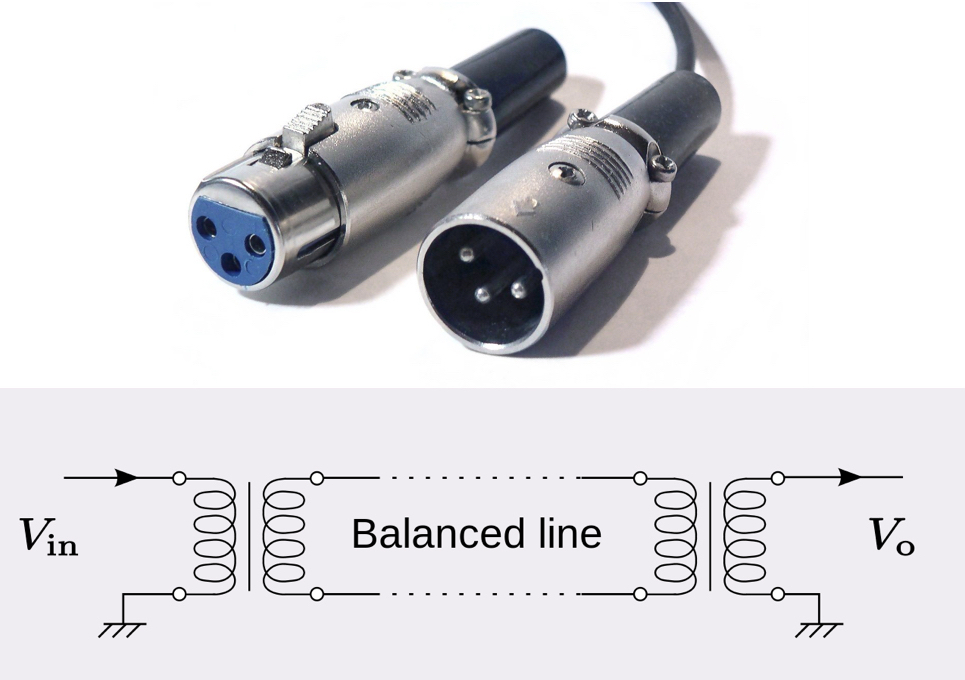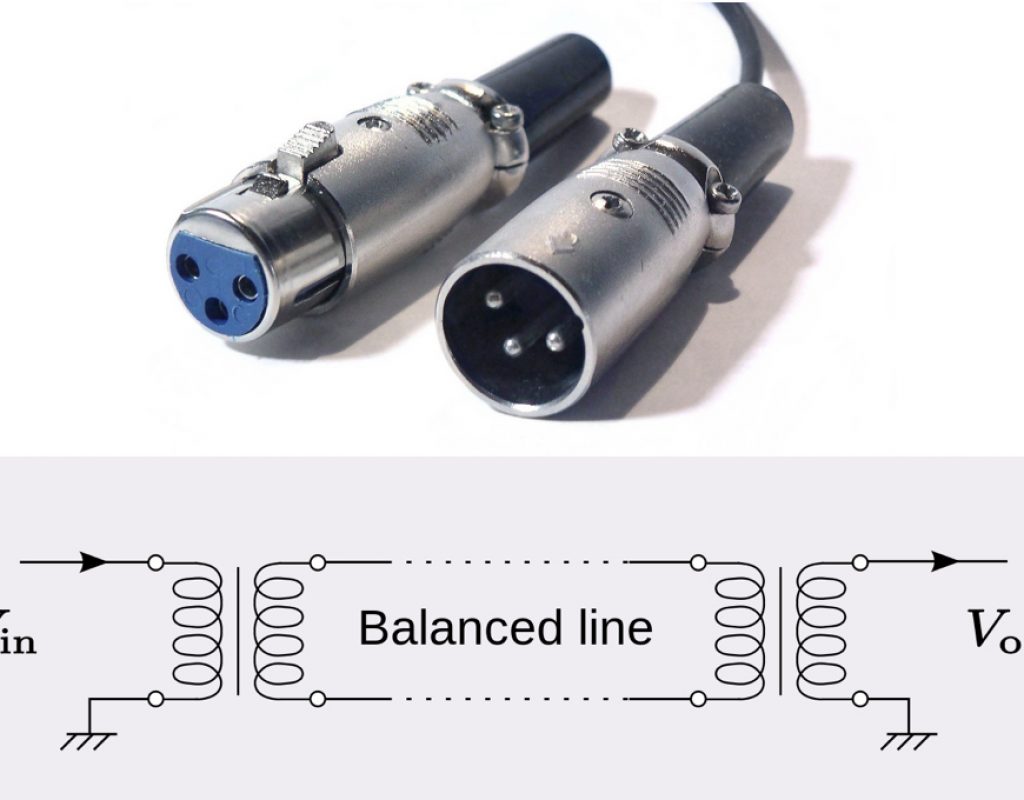
Balanced audio is often combined with a 3-pin XLR plug, although it can also use a TRS or Tip/Ring/Sleeve plug (mono balanced), screw terminals or other terminations. However, the mere use of those connections does not guarantee a balanced connection. The main advantage of balanced audio is its greater resistance to undesired interference, including EMI (electromagnetic interference) and RFI (radio frequency interference). This article will review how it’s accomplished and its different varieties, including transformer balance, electronic balance/active balance and the ingenious yet little-known impedance balanced approach.
Related article
You may also enjoy TS/TRS/TRRS/TRRRS: Combating the misconnection epidemic.
Basic concept of balanced audio and other signals
Balanced is a way where audio (or other signal) is sent from one device to another in such a way that the signal is sent over two conductors (often twisted together, and often with a shield or braid as an independent ground) with matching impedance. Below are examples of 3-pin XLR plugs and jacks (courtesy of Michael Piotrowski), one of the most common used for balanced audio (but not the only one, as indicated in the introductory paragraph).
The signal sent on each conductor is inverted in polarity. The differential (balanced) audio circuit is designed to measure the difference in voltage between the two conductors. Thankfully, any electromagnetic interference will cause an equal noise voltage on each conductor, so the interference on each will cancel out, leaving only the original signal without the noise.
Although with balanced audio, we nearly always use a shield or braid as an independent ground, two examples of true balanced signals that use no such shield or braid are: Ethernet cables with RJ-45 or other plugs (shown above, courtesy of Someone’s Moving Castle) and flat twin-lead 300 ohm antenna cable (shown below, courtesy of LuckyLouie). Both are truly balanced without any shield or braid.
On the other hand, coax cable (shown below, courtesy of Tkgd2007) is unbalanced with a shield, whether it is used with a BNC, RF or other plug.
Transformer balance
The easiest way to visualize a balanced line is through transformers at each end shown above (image courtesy of Spinningspark). Transformers were the original method of making such connections in telephony, and before the advent of active circuitry were the only way. Thanks to the induction coils used, transformers have the additional advantage of completely isolating the line from earth and earth loop currents, which are an undesirable possibility with other methods. Many devices from Sound Devices and Shure use a transformer balanced circuit. Many lower-cost mixers and interfaces use other balancing options, covered ahead. Dynamic microphones from many manufacturers also use a transformer, but not all.
Electronic balance/active balance
Electronic balance (aka active balance) is achieved using differential amplifiers at each end of the line. Unlike transformer balance, there is no physical isolation of the circuitry from the line. Each of the two wires is driven by an op amp circuit which are identical except that one is inverting and one is non-inverting. Each one produces an unbalanced signal individually but together they drive the line with a symmetrical balanced signal.
While it is not possible to create a truly isolated drive with op-amp circuitry alone, it is possible to create a floating output. To achieve that, additional feedback paths are required between the two op-amps resulting in a more complex circuit, but still avoiding the expense of a transformer. An isolated output can be achieved without transformers with the addition of opto-isolators.
Impedance balance
As I recently discovered when reading a detailed response I received from an engineer from RØDE regarding an amazing new product (review pending very soon… and it’s not a microphone!), despite its original definition, a balanced audio signal can indeed be achieved without transmitting absolutely any audio program information on the cold (phase inverted) conductor. This ingenious approach is called impedance balance. Following the EIA Standard RS-297-A standard (pin 2 hot), the silent signal on pin 3 still has the same impedance as pin 2 as sent to the receiving device (i.e. a mixer, recorder or camera with a differential input), and that’s why it is balanced. Even though there is no program audio on pin 3, that silent signal will still include any EMI or RFI noise which may be introduced on the way (which is indeed phase-inverted compared to the program signal on pin 2), and the balanced receiving device just sums the difference between the two pins, cancelling the noise and extracting only the desired audio signal! Fortunately, this approach is completely compatible with any differential (balanced) input circuit, even though it may have been designed before the existence of this type of signal. The signal is not symmetrical, but it indeed is still balanced, with all of the associated virtues.
Be sure to be on my mailing list to be sure to hear about this game-changing device and review, and other news about articles and books.
Upcoming articles, reviews, radio shows, books and seminars/webinars
Stand by for upcoming articles, reviews, and books. Sign up to my free mailing list by clicking here. Most of my current books are at books.AllanTepper.com, and my personal website is AllanTepper.com.
Si deseas suscribirte a mi lista en castellano, visita aquí. Si prefieres, puedes suscribirte a ambas listas (castellano e inglés).
Listen to his CapicúaFM show at CapicúaFM.com or subscribe via Apple Podcasts, Radio Public or Stitcher.
Save US$20 on Project Fi, Google’s mobile telephony and data
Click here to save US$20 on Project Fi, Google’s mobile telephone and data service which I have covered in these articles.
Learn to speak Castilian, the most widely used Spanish language
FTC disclosure
No manufacturer is specifically paying Allan Tépper or TecnoTur LLC to write this article or the mentioned books. Some of the other manufacturers listed above have contracted Tépper and/or TecnoTur LLC to carry out consulting and/or translations/localizations/transcreations. Many of the manufacturers listed above have sent Allan Tépper review units (including RØDE). So far, none of the manufacturers listed above is/are sponsors of the TecnoTur programs, although they are welcome to do so, and some are, may be (or may have been) sponsors of ProVideo Coalition magazine. Some links to third parties listed in this article and/or on this web page may indirectly benefit TecnoTur LLC via affiliate programs. Allan Tépper’s opinions are his own.
Copyright and use of this article
The articles contained in the TecnoTur channel in ProVideo Coalition magazine are copyright Allan Tépper/TecnoTur LLC, except where otherwise attributed. Unauthorized use is prohibited without prior approval, except for short quotes which link back to this page, which are encouraged!

